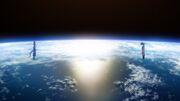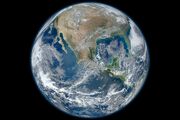- 903
- 142
The visual edition of this thread.
There are crimes (not really) being committed, generally by authors of Japanese comic fiction who tend to not draw to scale, or anything with large size properly.
Self explanatory and pretty brief. I see a lot of feats on the wiki where people are wrongly using curvature scaling even though they're well in Earth's atmosphere and large portions of the landscape are visible, as well as being around cloud level more often than not. The main culprit is height and dimensions. As height increases and you are still well within Earth's atmosphere, you're only witnessing the curvature of the horizon proportional to your height, not the curvature of the entire planet.
The threshold elevation for detecting curvature would seem to be somewhat less than 35,000 ft (10.67km) but not as low as 14,000 ft (4.267km). Photographically, curvature may be measurable as low as 20,000 (6.096km) ft. Though, its nothing as severe as seeing the curve of a sphere.
A lot of calculations use curvature scaling based on flawed artistic choices with mountains, building, forests etc. in detail in the background. This would mean Earth is the size of Pluto or its a planet of giants. Even at 12 kilometers, you can only notice a subtle curve in the horizon, but the same height in most manga are horribly exaggerated.
Of course, this doesn't just apply to celestial bodies, but giant objects that have high magnification on a partial image. For example, this scan being calculated like this, then the manga showing a much different shape when zoomed out.
Examples of bad curvature
1 2 3 4 5 6 7
More realistic curvature sources (still flawed though not nearly as much)
1 2 3 4 (The last one isn't good for finding height though)
Source
https://thulescientific.com/Lynch Curvature 2008.pdf
Conclusion
Improper use of curvature scaling jacks up results for no good reason and calculations that use them should be reevaluated.
There are crimes (not really) being committed, generally by authors of Japanese comic fiction who tend to not draw to scale, or anything with large size properly.
Self explanatory and pretty brief. I see a lot of feats on the wiki where people are wrongly using curvature scaling even though they're well in Earth's atmosphere and large portions of the landscape are visible, as well as being around cloud level more often than not. The main culprit is height and dimensions. As height increases and you are still well within Earth's atmosphere, you're only witnessing the curvature of the horizon proportional to your height, not the curvature of the entire planet.
The threshold elevation for detecting curvature would seem to be somewhat less than 35,000 ft (10.67km) but not as low as 14,000 ft (4.267km). Photographically, curvature may be measurable as low as 20,000 (6.096km) ft. Though, its nothing as severe as seeing the curve of a sphere.
A lot of calculations use curvature scaling based on flawed artistic choices with mountains, building, forests etc. in detail in the background. This would mean Earth is the size of Pluto or its a planet of giants. Even at 12 kilometers, you can only notice a subtle curve in the horizon, but the same height in most manga are horribly exaggerated.
Of course, this doesn't just apply to celestial bodies, but giant objects that have high magnification on a partial image. For example, this scan being calculated like this, then the manga showing a much different shape when zoomed out.
Examples of bad curvature
1 2 3 4 5 6 7
More realistic curvature sources (still flawed though not nearly as much)
1 2 3 4 (The last one isn't good for finding height though)
Source
https://thulescientific.com/Lynch Curvature 2008.pdf
Conclusion
Improper use of curvature scaling jacks up results for no good reason and calculations that use them should be reevaluated.



